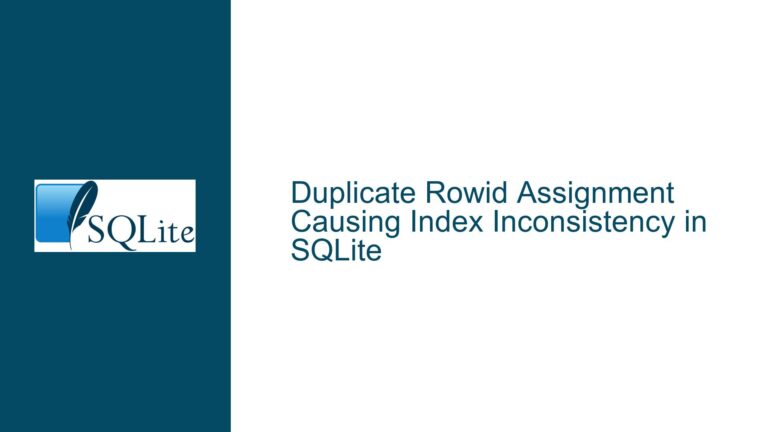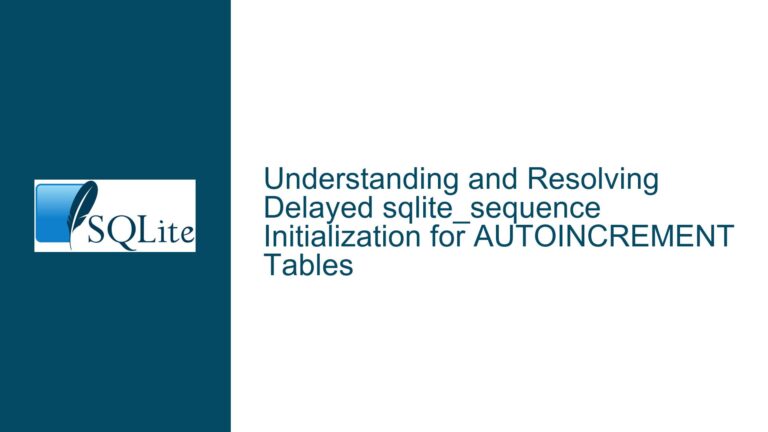Rowid Management in Contentless FTS5 Tables for Full-Text Search
Rowid Misalignment in Contentless FTS5 Tables During Insertions and Deletions
When implementing full-text search using SQLite’s FTS5 virtual table, particularly in contentless FTS5 tables, one of the most common issues developers encounter is the misalignment of rowids during insertions and deletions. In a typical SQLite table, each row is assigned a unique rowid that serves as its primary key. This rowid is automatically incremented and is crucial for maintaining the integrity and order of the data. However, in contentless FTS5 tables, the behavior of rowids can lead to unexpected results, especially when rows are inserted or deleted.
In a contentless FTS5 table, the rowid is used to link the full-text search index to the original data in an external table. The expectation is that the rowid in the FTS5 table will correspond directly to the rowid in the external table. However, when rows are deleted from the external table, gaps are left in the sequence of rowids. Similarly, when new rows are inserted, they may be assigned rowids that conflict with existing ones. This misalignment can cause significant issues in applications that rely on the consistency of rowids for operations such as indexing, searching, and data retrieval.
The core of the problem lies in the way SQLite handles rowids in contentless FTS5 tables. Unlike regular tables, where rowids are automatically adjusted to fill gaps after deletions, FTS5 tables do not automatically adjust rowids. This behavior is by design, as adjusting rowids in a full-text search index would require reindexing the entire table, which could be computationally expensive. However, this design choice can lead to inconsistencies when the external table undergoes frequent insertions and deletions.
Gaps in Rowid Sequence Due to Deletions and Insertions
The primary cause of rowid misalignment in contentless FTS5 tables is the presence of gaps in the rowid sequence caused by deletions and insertions. When a row is deleted from the external table, the corresponding rowid in the FTS5 table is not automatically removed or adjusted. This leaves a gap in the sequence of rowids, which can cause issues when new rows are inserted. If a new row is inserted into the external table, it may be assigned a rowid that was previously used by a deleted row. This can lead to conflicts in the FTS5 table, where the same rowid may now point to a different set of data.
Another contributing factor is the way SQLite assigns rowids to new rows. By default, SQLite assigns the lowest available rowid to a new row. This means that if a row is deleted, its rowid becomes available for reuse. When a new row is inserted, it may be assigned the rowid of a previously deleted row. In a contentless FTS5 table, this can lead to situations where the same rowid points to different data in the external table, causing inconsistencies in the full-text search index.
The issue is further complicated by the fact that contentless FTS5 tables do not automatically update their rowids when rows are deleted from the external table. This means that the FTS5 table may still contain references to rowids that no longer exist in the external table. When a search is performed, these orphaned rowids can lead to incorrect or incomplete results, as the FTS5 table may return results that no longer correspond to valid data in the external table.
Implementing Rowid Synchronization and Index Maintenance
To address the issue of rowid misalignment in contentless FTS5 tables, it is necessary to implement a strategy for synchronizing rowids between the external table and the FTS5 table. This can be achieved through a combination of manual rowid management and regular index maintenance.
One approach is to manually adjust the rowids in the FTS5 table whenever rows are inserted or deleted from the external table. This can be done by using the INSERT and DELETE triggers on the external table to update the corresponding rowids in the FTS5 table. For example, when a row is deleted from the external table, a trigger can be used to remove the corresponding rowid from the FTS5 table. Similarly, when a new row is inserted into the external table, a trigger can be used to assign a new rowid in the FTS5 table.
Another approach is to use a separate table to map rowids between the external table and the FTS5 table. This mapping table can be used to keep track of the relationship between rowids in the external table and the FTS5 table. When a row is deleted from the external table, the corresponding entry in the mapping table can be removed. When a new row is inserted, a new entry can be added to the mapping table. This approach allows for more flexible rowid management and can help to prevent conflicts in the FTS5 table.
In addition to manual rowid management, it is also important to perform regular index maintenance on the FTS5 table. This can be done using the REINDEX command, which rebuilds the full-text search index and ensures that it is consistent with the data in the external table. Regular index maintenance can help to prevent the accumulation of orphaned rowids in the FTS5 table and ensure that search results are accurate and up-to-date.
Finally, it is worth considering the use of a different full-text search engine if the requirements of the application cannot be met with SQLite’s FTS5. While FTS5 is a powerful and lightweight solution for many use cases, it may not be suitable for applications that require frequent insertions and deletions and strict rowid consistency. In such cases, alternative full-text search engines, such as Elasticsearch or Apache Lucene, may be more appropriate. These engines offer more advanced features for managing rowids and maintaining index consistency, although they may also introduce additional complexity and overhead.
In conclusion, managing rowids in contentless FTS5 tables requires careful consideration of the issues that can arise from deletions and insertions. By implementing a strategy for synchronizing rowids and performing regular index maintenance, it is possible to maintain the consistency and accuracy of the full-text search index. However, it is also important to recognize the limitations of FTS5 and consider alternative solutions if the requirements of the application cannot be met.






